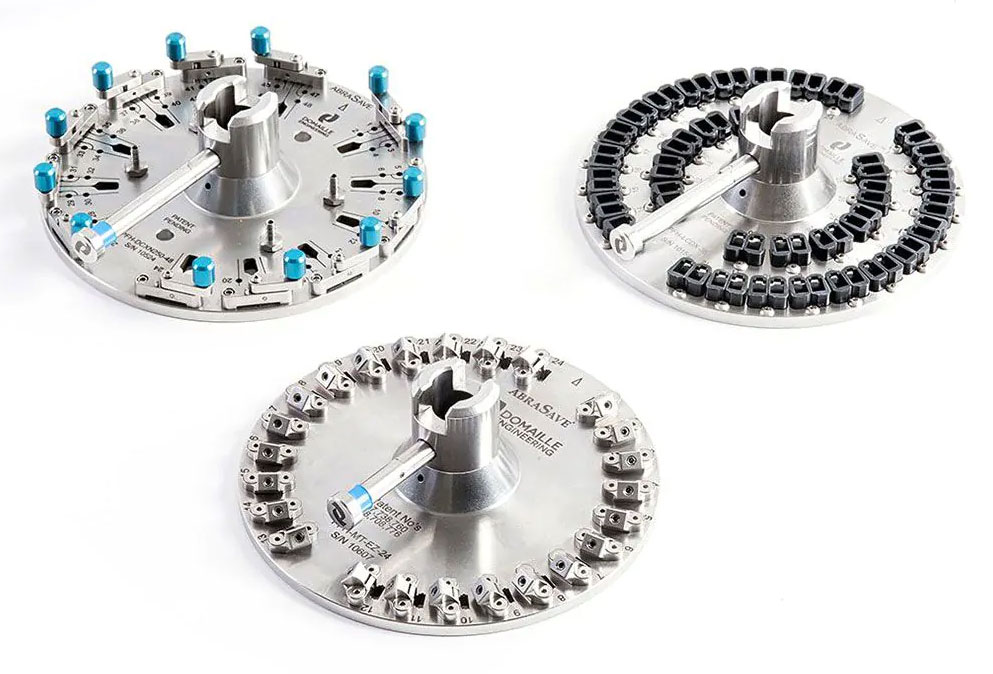In fiber optic cable assembly, the polishing process is perhaps the most critical step to assure high-quality assemblies that meet specifications. That’s why it’s important to select the right optical fiber polishing machine – and polishing fixtures – that meet your needs. Depending on your cable assembly house product offerings, it’s likely that you have several polishing fixtures to produce different connector styles.
The quality of the polishing fixtures (also called polishing plates or jigs) is extremely important to your company. Considering the high cost of production equipment and components, your company will want to maintain these tools to produce a high volume of products with minimal quality issues over the long run.
Proper maintenance of polishing fixtures is absolutely essential
Polishing fixtures for optical fiber polishing machines are built with high-precision machining equipment. Fixtures made of steel and aluminum can flex and warp over time, which will negatively impact your polishing process and product quality. On the other hand, polishing fixtures made of hardened stainless steel avoid this wear effect. However, hardened stainless steel contains more iron in the alloy, so this does increase the risk of rusting. This is a key reason why proper maintenance is so critical.
In addition, the most common fiber optic connectors (SC, LC, and E2000) are locked onto the polishing fixture with a plastic latch or clamp, which can wear over time if not properly cleaned. Poor cleaning techniques can also prevent proper locking. This can significantly impact the polishing machine’s functionality and, therefore, product quality.
Polishing fixtures are expensive – this is a bottom-line reason why proper maintenance is so important. With daily maintenance, you can use your polishing fixtures for a long time with no variation in the quality level of your fiber optic cable assemblies.
Follow these 8 steps to clean and maintain your polishing fixtures
Whether your company is just starting to manufacture fiber optic cable assemblies – or you have years of experience – we recommend you rigorously follow these guidelines to properly clean and maintain your polishing fixtures.
- It’s better to clean every day for 5 minutes rather than clean once a week for 30 minutes. In fact, we recommend you integrate a cleaning procedure throughout the daily polishing process. Cleaning the fixtures should be a regular task – and a priority – in your polishing process.
- Use distilled water, because it doesn’t contain abrasive minerals. Do not use tap water – regular drinking water is different all over the world. Your company’s tap water may contain iron minerals that tend to adhere to the polishing fixture. Also, do not use alcohol. At Fiber Optic Center, we recommend the Air Cleanse Cleaning Wand. This hand-held cleaning wand has an integrated pressurized fluid and filter system for a debris-free cleaning operation. You can use the wand to clean any brand of polishing machine and fixture.
- The ferrule holes (and for MT style fixtures the ferrule slots, surrounding surfaces, and top clamps) can be cleaned using dental brushes and particle‐free, distilled or deionized water. Again, do not use alcohol. We recommend using a 1.25mm nylon brush for fixtures with 1.25mm diameter ferrule holes. Use a 2.5mm nylon brush (blue-handled brush) for fixtures with 2.5mm diameter ferrule holes. Either one will work fine for MT-style fixtures.
- Clean the fixture while it’s still wet from the polishing process. This makes it easy to remove the polishing debris.
- To clean areas where a brush can’t reach, use an ultrasonic bath. When using an ultrasonic bath, you must change the deionized water every day. Otherwise, debris could contaminate the polishing fixture. (Again, here is the link for the Air Cleanse Cleaning Wand datasheet.)
- If you have a fixture with a cam-lock interface, pay special attention to the spring slits. These are very narrow and debris can easily build up, causing the metal to flex less and interfere with the spring functionality.
- After cleaning the polishing fixture, it’s important to dry it thoroughly to avoid rusting. This is especially true for polishing fixtures made of hardened stainless steel.
- Over time, your polishing results may change, and the reason could be directly related to the natural wear of key interfaces of the polishing machine and fixture. The EZ-Check Precision Wear Gage Kit provides precise measurements for the polishing machine mandrel, fixture mounting hole, and ferrule holes. We recommend incorporating this wear gage kit into your process control system. Call Fiber Optic Center to determine whether this tool works with your polishing machine and fixture. Click to read the datasheet for the EZ-Check Precision Wear Gage Kit from Domaille Engineering.

Additional tip
Monitoring the end-face geometries of polished ferrules is an excellent way to monitor the quality of your polishing fixture. Any significant deficiencies in the fixture will be reflected in end-face geometry parameters.
For example, changes in Apex Offset can indicate possible fixture hole wear or contamination. Changes in Radius can indicate possible poor latching or a worn clamping mechanism. When this situation occurs – if nothing has changed in the polishing process – it may be a good time to replace the plastic latch or the polishing fixture.
Conclusion
As noted earlier, the polishing process may be the most critical step to ensure high-quality fiber optic cable assemblies. We hope these maintenance and cleaning guidelines will help you better utilize these critical tools to avoid quality problems – and avoid the rapid deterioration of this expensive equipment.
If you have questions about setting up or improving your polishing process, we encourage you to email your question to AskFOC@focenter.com. One of our technical experts will answer your question as quickly as possible. Our goal is to help you make world-class fiber optic cable assemblies that meet international standards for quality, performance, and reliability.
QUICK LINKS – Click to learn more about these polishing machines and components:
- Domaille polishing machines
- Seikoh Giken polishing machines
- Field-use polishing machines for repair work
ARTICLES – Click to read more about the polishing process and continue your education:
- Steps to Overcome Common APC Polishing Issues
- How to Develop a Fiber Optic Polishing Process that Produces Consistent Results
- APC Polishing Advice to Improve Apex Offset and Angle Measurements
- Why Isn’t There One Standard Polishing Procedure?
- Why Use ÅngströmLap Lapping Film Over Other Manufacturers?
- Using Chemical Mechanical Planarization (CMP) to Polish MT Ferrules and Get Repeatable, Predictable Results
Additional resources from the FOC team include:
- View Polishing Technical Solution Content
- View the Glossary, Acronyms, Military Specifications for Connectors
- Q&A Resource: email technical questions to AskFOC@focenter.com



